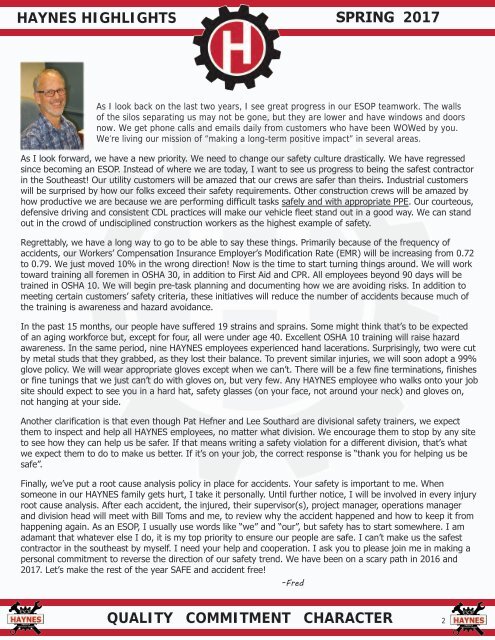You also want an ePaper? Increase the reach of your titles
YUMPU automatically turns print PDFs into web optimized ePapers that Google loves.
<strong>HAYNES</strong> HIGHLIGHTS SPRING <strong>2017</strong><br />
As I look back on the last two years, I see great progress in our ESOP teamwork. The walls<br />
of the silos separating us may not be gone, but they are lower and have windows and doors<br />
now. We get phone calls and emails daily from customers who have been WOWed by you.<br />
We’re living our mission of “making a long-term positive impact” in several areas.<br />
As I look forward, we have a new priority. We need to change our safety culture drastically. We have regressed<br />
since becoming an ESOP. Instead of where we are today, I want to see us progress to being the safest contractor<br />
in the Southeast! Our utility customers will be amazed that our crews are safer than theirs. Industrial customers<br />
will be surprised by how our folks exceed their safety requirements. Other construction crews will be amazed by<br />
how productive we are because we are performing difficult tasks safely and with appropriate PPE. Our courteous,<br />
defensive driving and consistent CDL practices will make our vehicle fleet stand out in a good way. We can stand<br />
out in the crowd of undisciplined construction workers as the highest example of safety.<br />
Regrettably, we have a long way to go to be able to say these things. Primarily because of the frequency of<br />
accidents, our Workers’ Compensation Insurance Employer’s Modification Rate (EMR) will be increasing from 0.72<br />
to 0.79. We just moved 10% in the wrong direction! Now is the time to start turning things around. We will work<br />
toward training all foremen in OSHA 30, in addition to First Aid and CPR. All employees beyond 90 days will be<br />
trained in OSHA 10. We will begin pre-task planning and documenting how we are avoiding risks. In addition to<br />
meeting certain customers’ safety criteria, these initiatives will reduce the number of accidents because much of<br />
the training is awareness and hazard avoidance.<br />
In the past 15 months, our people have suffered 19 strains and sprains. Some might think that’s to be expected<br />
of an aging workforce but, except for four, all were under age 40. Excellent OSHA 10 training will raise hazard<br />
awareness. In the same period, nine <strong>HAYNES</strong> employees experienced hand lacerations. Surprisingly, two were cut<br />
by metal studs that they grabbed, as they lost their balance. To prevent similar injuries, we will soon adopt a 99%<br />
glove policy. We will wear appropriate gloves except when we can’t. There will be a few fine terminations, finishes<br />
or fine tunings that we just can’t do with gloves on, but very few. Any <strong>HAYNES</strong> employee who walks onto your job<br />
site should expect to see you in a hard hat, safety glasses (on your face, not around your neck) and gloves on,<br />
not hanging at your side.<br />
Another clarification is that even though Pat Hefner and Lee Southard are divisional safety trainers, we expect<br />
them to inspect and help all <strong>HAYNES</strong> employees, no matter what division. We encourage them to stop by any site<br />
to see how they can help us be safer. If that means writing a safety violation for a different division, that’s what<br />
we expect them to do to make us better. If it’s on your job, the correct response is “thank you for helping us be<br />
safe”.<br />
Finally, we’ve put a root cause analysis policy in place for accidents. Your safety is important to me. When<br />
someone in our <strong>HAYNES</strong> family gets hurt, I take it personally. Until further notice, I will be involved in every injury<br />
root cause analysis. After each accident, the injured, their supervisor(s), project manager, operations manager<br />
and division head will meet with Bill Toms and me, to review why the accident happened and how to keep it from<br />
happening again. As an ESOP, I usually use words like “we” and “our”, but safety has to start somewhere. I am<br />
adamant that whatever else I do, it is my top priority to ensure our people are safe. I can’t make us the safest<br />
contractor in the southeast by myself. I need your help and cooperation. I ask you to please join me in making a<br />
personal commitment to reverse the direction of our safety trend. We have been on a scary path in 2016 and<br />
<strong>2017</strong>. Let’s make the rest of the year SAFE and accident free!<br />
-Fred<br />
QUALITY COMMITMENT CHARACTER<br />
2


